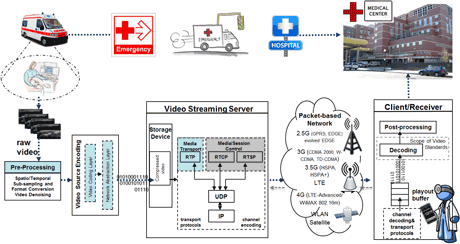by Andreas S. Panayides and Anthony G. Constantinides
The objective of the DRIVEN project is to develop a unifying framework for the diagnostically-resilient communication of medical video over emerging 3.5G and 4G wireless networks that is suitable for critically-needed clinical diagnosis. The goal is to develop new and integrate state-of-the-art methods in video coding, wireless networks, and medical video quality assessment into an adaptive, automated framework. It is anticipated that the integrated system will aid in establishing mobile-health (m-health) medical video communication systems in standard clinical practice.
{jcomments on}Cardiovascular disease (CVD) causes nearly half of all deaths in Europe. The Medical Standing Committee of the European Science Foundation has recognized the development of new technologies for cardiovascular diseases as a target priority.
The Diagnostically Robust Ultrasound Video Transmission over Emerging Wireless Networks (DRIVEN) framework, which can support any medical video modality, is currently validated for remote diagnosis of two life threatening cardiovascular conditions: symptomatic atherosclerotic plaque (associated with critical stroke events) and abdominal aortic aneurysm (AAA), which can cause life-threatening internal bleeding. In both cases, timely intervention, especially for the elderly and patients with mobility problems will be supported by the proposed m-health ultrasound video transmission system.
The system also has the potential to assist with early diagnosis of patients in remote locations and mass population screening, especially in developing countries, to reduce patients’ risks of more general cardiovascular diseases. Other application scenarios range from emergency telematics, which provide a critical time advantage for the patient’s survival, to second opinion provision and medical education. The objective is to establish how specific diagnostic decisions can be safely made based on the transmitted medical video.

Figure 1 depicts the basic system components required for real-time transmission of medical ultrasound video. This procedure comprises four steps: raw medical video is first pre-processed so that it is suitable for encoding. This step typically involves video resolution and frame rate adjustments, as well as video de-noising where applicable. Video coding standards are then used to compress the video. Given the best available wireless transmission medium, the medical video is transmitted to the remote location where the reverse procedure is followed for decoding, post-processing and error recovery.
Over the last decade, there has been an impressive growth in the development of m-health systems and services [1]. In spite of this remarkable growth, there has been limited penetration into standard clinical practice. This is in part due to the inability of wireless networks of the previous decade to support data transfer rates that would allow medical video communications at the acquired video resolution and frame rate. The clinical capacity of the communicated medical video is compromised when the transmitted video is of limited resolution, and the same holds for clinical motion when restricting the frame rate. Moreover, the compression ratio cannot be tolerated to fall below diagnostically acceptable levels. The efficiency of medical video transmission systems is measured in terms of their ability to provide for a reliable and dependable diagnosis. Degradation of clinically-sensitive regions can lead to unacceptable deterioration of the system’s objective of remote diagnosis.
High-resolution low-delay and high frame-rate medical video communication over 3.5G mobile WIMAX and HSPA wireless networks using diagnostically driven techniques is demonstrated by the DRIVEN platform in [2], [3]. Diagnostically driven methods adapt the encoding, transmission, and evaluation process to the underlying medical video modality, aiming to maximize the diagnostic capacity of the transmitted medical video. Clinically-sensitive video regions form diagnostic regions-of-interest (d-ROI) which are in turn encoded in higher quality than non-diagnostically important regions, protected more strongly during transmission, and assigned higher-importance weights during video quality assessment.
On-going work includes integrating the new High Efficiency Video Coding (HEVC) standard in the DRIVEN framework, which together with 4G wireless networks deployment, is expected to play a decisive role in communicating medical video that can rival the standards of in-hospital examinations. The use of medical video at the clinically acquired resolution and frame rate that can be robustly transmitted in low-delay without compromising clinical quality will aid in wider adoption of m-health systems and services in standard clinical practice.
The DRIVEN project (12/2012-11/2014) is coordinated by the Communication and Signal Processing Group at Imperial College London and is funded by Marie-Curie Intra-European Fellowships scheme. Collaborators are the Electronic Health laboratory at the University of Cyprus (UCY), while medical ultrasound video acquisition, evaluation, and remote diagnosis are performed by medical experts at Imperial College, the Vascular Non-invasive Diagnostic Centre (VNDC) in London, UK, and the Cyprus Institute of Neurology and Genetics (CING) in Nicosia, Cyprus.
References:
[1] E. Kyriacou et al.: “m-Health e-Emergency Systems: Current Status and Future Directions”, IEEE Antennas Propag. Mag., vol. 49(1), pp. 216-231, Feb. 2007.
[2] A. Panayides et al.: “High-Resolution, Low-delay, and Error-resilient Medical Ultrasound Video Communication Using H.264/AVC Over Mobile WiMAX Networks,” IEEE J-BHI vol.17(3), pp.619-628, May 2013.
[3] A. Panayides, I. Eleftheriou, M. Pantziaris, “Open-Source Telemedicine Platform for Wireless Medical Video Communication,” Int J Telemed Appl, Article ID 457491, 2013.
Please contact:
Andreas S. Panayides,
Imperial College London, UK.
E-mail:











